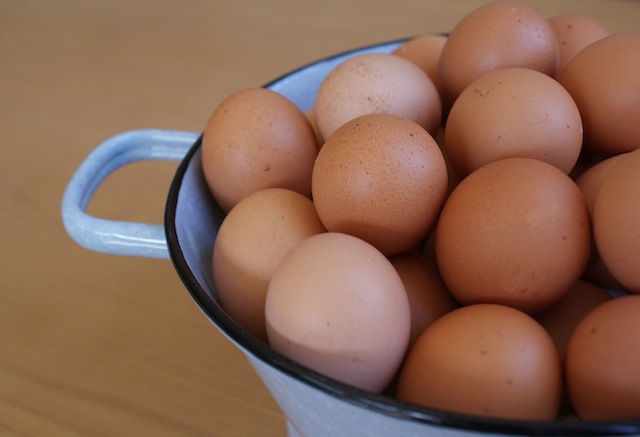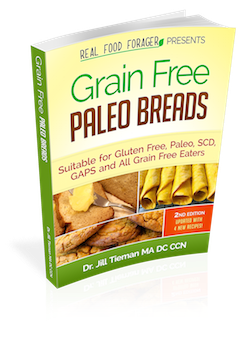There was good news in the health sector recently. Several news items reported that in their latest analysis the USDA has found that eggs actually contain less cholesterol than they did in 2002. In addition, today’s eggs have more vitamin D than in 2002. “The American Egg Board attributes the changes to improvements in American farmers’ hen feed, which includes a vitamin D supplement.” I guess the improvements to hen feed are the GM corn and GM soy that hens are fed. Not to mention the hormones, antibiotics, arsenic and other goodies. Certainly the hens would need a vitamin D supplement because conventional hens are confined and typically never see the light of day, have the ability to run around and forage for bugs, worms or what-have-you, or have the warm sun on their back in order to generate vitamin D naturally.
Theses factory chickens are not allowed to express their “chickenness,” as Joel Salatin would say, owner of the acclaimed Polyface Farm in Virginia. Chickens are omnivores. That means they are part vegetarian as well as part carnivore. They need both groups to round out their diet in order to provide them with optimum nutrition. If the hens are optimally healthy, the super nutrient-dense eggs will follow. At pasture based farms, the chickens are moved to new pasture each day and they follow the cows and peck through the cow pies for insects. It is a self-sustaining operation and the animals are treated humanely and with dignity.
Compare that to a CAFO (concentrated animal feeding operation) which is essentially a factory to fatten up animals as quickly as possible without regard to their health and well being for the duration of their short lives. CAFO is an acronym orchestrated by the EPA in order to classify these factories as potential polluters. And they are polluters. Massive amounts of animal waste products run off into the waterways and pollute the surrounding areas. This is how salmonella and other pathogens get into food products. The animal waste product run off affects agricultural lands. How else to get rid of the animal waste? Well, the model of Polyface Farm shows us how. There animals live the life they were designed to live and their waste fertilizes the land and recharges the topsoil for new pasture. This is what sustainable farming is all about, and there is much to learn from farmers like Joel Salatin.
But the real good news that I was sarcastically referring to was that the eggs now have less cholesterol. Apparently, the cholesterol-lowering claims made by the soy industry really are true. So, the USDA and the American Egg Board can pat themselves on the back for producing an egg with even less nutrients than before. Will this condemnation of fats and cholesterol never end? Eggs are a sacred food. They have been highly prized in all traditional cultures since forever. The yolks carry most of the nutrition: fat soluble vitamins—A, D, E, K—as well as choline, a nutrient absolutely essential for the brain. There are also about about 180 mgs of cholesterol, down from the former 220 mgs. In addition, the white of the egg adds about 7 grams of a complete protein (having all eight essential amino acids). But the real point here is that dietary cholesterol has nothing to do with serum blood levels. Your body will make more or less cholesterol depending upon need, not diet. Therefore using a lower cholesterol count as a way to market commercial eggs is inappropriate.
Pastured eggs have a rich vibrant yellow orange color that conventional eggs lack. The color tells you that this is a more nutrient dense product than the conventional egg. This egg is full of fat soluble vitamins as mentioned above, as well as B complex, and minerals such as calcium, potassium, iron and phosphorus. The deeper the color, the more carotenes, such as lutein and zeaxanthin. These two carotenes have been identified as being essential to healthy vision by supporting the macula and preventing cataracts. They are also identified as helping to prevent breast and colon cancer. Compared to eggs from conventionally raised, caged hens, eggs produced by pastured chickens have more omega-3 fatty acids, vitamin E and vitamin A, naturally occurring vitamin D, along with notably higher amounts of folic acid and vitamin B12. All of these nutrients are essential for the developing embryo. And they are so nutritious for children and adults as well.
Yet again, the food industry has taken a perfect food from nature, one that has nourished people for thousands of years, and they have managed to change it for the worse. A lower cholesterol, factory egg will not compare in nutrient quality and quantity to a pastured egg.
The SOLUTION is to support your local farmer and buy real farm fresh eggs, directly from a biodynamic farmer. To find a local farmer in your area, go to the Weston Price Foundation Chapter Page and contact a chapter near your home. These wonderful, nutrient dense, wholesome eggs, are so fresh and safe, they can be eaten raw, as in raw yolks in a smoothie, or raw eggs in easy food recipes such as homemade mayonnaise. (Do not make a habit of eating raw egg whites.) Pastured eggs are a perfect food. Do not be afraid to incorporate them into meals every day.











